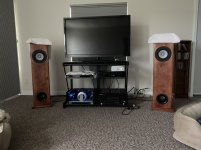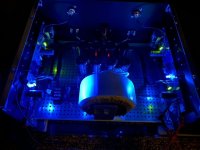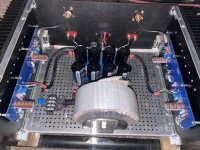Hey everyone,
welcome back to the obsession!
Can’t believe how much I missed this site.
Anyway, I just completed an F6 amplifier and have 15 hours on it now. I have the bias set at 560 mv on both channels. The bias is stable and I’ve only adjusted it from 510 to 560 and only after amplifier is fully warmed up. I’ve been monitoring heatsink temperatures with an IR thermometer and see 51c at pin 2 on mosfet. The temperature varies on each mosfet though I’m not sure how much that matters. I’m monitoring highest temperature before bias adjustment. All that said I haven’t noticed much change in sound quality yet. I suppose patience is in order? I’ve been using my Onkyo CDP C7030 as a source and for the first time last night I switched the source to my Mac mini through my HRT music streamer. It’s an asynchronous usb dac that I’ve had for several years but sadly is my only option for conversion duties when using the mini. The difference in SQ was quite noticeable. So apparently the dac in my cdp is somewhat better than my HRT. My speakers are diy full range using MarkAudio 12p. I’m hoping for suggestions, should I increase bias to 600 mv or just let it run in longer? I do have a diy dac planned but given how long it took to get my f6 going it’s going to be awhile before that’s ready. Suggestions, please
Sure is great to have the site back 😃
Regards
welcome back to the obsession!
Can’t believe how much I missed this site.
Anyway, I just completed an F6 amplifier and have 15 hours on it now. I have the bias set at 560 mv on both channels. The bias is stable and I’ve only adjusted it from 510 to 560 and only after amplifier is fully warmed up. I’ve been monitoring heatsink temperatures with an IR thermometer and see 51c at pin 2 on mosfet. The temperature varies on each mosfet though I’m not sure how much that matters. I’m monitoring highest temperature before bias adjustment. All that said I haven’t noticed much change in sound quality yet. I suppose patience is in order? I’ve been using my Onkyo CDP C7030 as a source and for the first time last night I switched the source to my Mac mini through my HRT music streamer. It’s an asynchronous usb dac that I’ve had for several years but sadly is my only option for conversion duties when using the mini. The difference in SQ was quite noticeable. So apparently the dac in my cdp is somewhat better than my HRT. My speakers are diy full range using MarkAudio 12p. I’m hoping for suggestions, should I increase bias to 600 mv or just let it run in longer? I do have a diy dac planned but given how long it took to get my f6 going it’s going to be awhile before that’s ready. Suggestions, please
Sure is great to have the site back 😃
Regards
Attachments
It will take at least 20 hours to get a sense of what your amp configuration sounds like, and more like 100 hours before it has really settled down.
So, of course the logical thing to do is listen to it for a good while, then try another bias current setting. 😉
So, of course the logical thing to do is listen to it for a good while, then try another bias current setting. 😉
It will take at least 20 hours to get a sense of what your amp configuration sounds like, and more like 100 hours before it has really settled down.
So, of course the logical thing to do is listen to it for a good while, then try another bias current setting. 😉
ThanksIt will take at least 20 hours to get a sense of what your amp configuration sounds like, and more like 100 hours before it has really settled down.
So, of course the logical thing to do is listen to it for a good while, then try another bias current setting. 😉
I will try to do just that 👍
Not sure these qualify,you are good at 55° on heatsink... look nice speaker but no amp porn??
Attachments
Installing the faceplate may help improve the thermal dissipation if you can get good physical contact between it and the ends of the main heatsinks.
Thanks Bill,Nice looking build. I like the transformer mounting bracket. HeyBill
That’s a construction bracket. Got that idea from a member.
Last edited:
I have so much trouble adjusting bias as it is I’m not sure how I’d accomplish it with that in place. Darn small screwdriver and an impossible little slot on the pot. Old guy excuses…..Installing the faceplate may help improve the thermal dissipation if you can get good physical contact between it and the ends of the main heatsinks.
Putting the top cover on hasn’t changed temps much. I don’t intend to put the bottom on. Probably won’t put face on till I’m satisfied with the sound
Regards
On HI-FI 2000 cases, contact between heatsinks and front plate is usually good and front plate pulls away considerable amount of heat. On my 4U/400 case, while heatsinks are at 40 degrees, front plate is at 30 degrees. This is without any thermal paste between those parts. So, if heatsinks are at barely acceptable high temperature without front plate, they will be OK with front plate mounted.
Thanks tombo,
So far, heat hasn’t been an issue. I’ve measured in several different locations and have yet to see more than 52C. Specifically at pin 2 on all 4 mosfets. I can put my hand on the heatsinks and just keep it there. Yes it’s warm but not hot. I thought putting the top cover on would increase temperatures but that hasn’t been the case. I’ve measured in various locations trying to locate the hottest areas but again nothing beyond 52C. Last night I increased the bias on both channels to 600 mv and set offset at .010 vdc. This was after playing for 2 hours. I shut it off after an additional 2 hours. All this without faceplate or top and bottom covers in place.
Sound quality seems to be improving, so today I will put top and front cover on and continue run-in for several more hours.
It’s 4:30 am here, time for another cup of joe.
Thanks for your insight
So far, heat hasn’t been an issue. I’ve measured in several different locations and have yet to see more than 52C. Specifically at pin 2 on all 4 mosfets. I can put my hand on the heatsinks and just keep it there. Yes it’s warm but not hot. I thought putting the top cover on would increase temperatures but that hasn’t been the case. I’ve measured in various locations trying to locate the hottest areas but again nothing beyond 52C. Last night I increased the bias on both channels to 600 mv and set offset at .010 vdc. This was after playing for 2 hours. I shut it off after an additional 2 hours. All this without faceplate or top and bottom covers in place.
Sound quality seems to be improving, so today I will put top and front cover on and continue run-in for several more hours.
It’s 4:30 am here, time for another cup of joe.
Thanks for your insight
The bias current has some dependency on temp so you need to do the final adjustment with the case complete with the lid on.
You can clip test leads on the 0.47 ohm source resistor leading to your multimeter on the outside the amp and then just put the lid on top.
Then run it for a couple hours while monitoring the dc offset and bias current. Make adjustments if needed and then put
the lid back on and wait for temp/bias to stabilize. Repeat as required. 🙂
Just take your time.
Cheers,
Dennis
You can clip test leads on the 0.47 ohm source resistor leading to your multimeter on the outside the amp and then just put the lid on top.
Then run it for a couple hours while monitoring the dc offset and bias current. Make adjustments if needed and then put
the lid back on and wait for temp/bias to stabilize. Repeat as required. 🙂
Just take your time.
Cheers,
Dennis
I have experimented with My F6.
Bias raised up as far as 800mv. (300 size case, but quite low room temp, so heatsinks not over hot.)
My impression was that the sound, top-end went very harsh. Overall 600 - 650 sounds better to me.
(This is just my opinion with my amp.)
Bias raised up as far as 800mv. (300 size case, but quite low room temp, so heatsinks not over hot.)
My impression was that the sound, top-end went very harsh. Overall 600 - 650 sounds better to me.
(This is just my opinion with my amp.)
Last edited:
Thanks Colin,
Wow, 800mv, not sure I will test those waters. My room temperature is also low. Once I get the top and face plates attached I may experiment further.
Regards
Wow, 800mv, not sure I will test those waters. My room temperature is also low. Once I get the top and face plates attached I may experiment further.
Regards
Thanks valowen,Hi, intojazz. Welcome back. Congratz with your F6 🙂
So far I’ve been very conservative. The bias has been 575mv on both channels for several hours. At some point I intend to increase to 600mv. But I’m in no rush. For now I’m beginning to look more closely at building a dac. Curious what you’ve built and what your system is like?
Regards
Just to complete this small thread,
The bias is stable on both channels at 625 mv as is offset @ .02 mv. I’ve not changed either for at least 20 hours of run time while the amp total hours is closer to 60. These measurements were all done with faceplate on and top secured. I’ve left the bottom plate off and likely will never install it. Mosfet temps at pin 2 are becoming more stable as well. I’m seeing a fairly consistent 52c in three locations and closer to 60c in one other. I have begun to notice the amp settling in. I’m not sure how to qualify that except it does seem a bit smoother at all frequencies and some harshness is gone especially so on higher frequencies. So there you have it, at this point I will secure the top and just continue listening
On to a dac build now……
Thanks everyone for helping and my best to all in the holiday season
The bias is stable on both channels at 625 mv as is offset @ .02 mv. I’ve not changed either for at least 20 hours of run time while the amp total hours is closer to 60. These measurements were all done with faceplate on and top secured. I’ve left the bottom plate off and likely will never install it. Mosfet temps at pin 2 are becoming more stable as well. I’m seeing a fairly consistent 52c in three locations and closer to 60c in one other. I have begun to notice the amp settling in. I’m not sure how to qualify that except it does seem a bit smoother at all frequencies and some harshness is gone especially so on higher frequencies. So there you have it, at this point I will secure the top and just continue listening
On to a dac build now……
Thanks everyone for helping and my best to all in the holiday season



